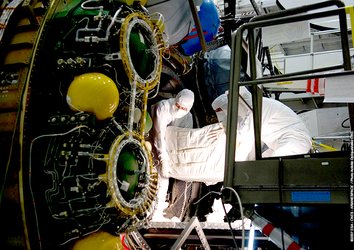Accept all cookies Accept only essential cookies See our Cookie Notice

About ESA
The European Space Agency (ESA) is Europe’s gateway to space. Its mission is to shape the development of Europe’s space capability and ensure that investment in space continues to deliver benefits to the citizens of Europe and the world.
Highlights
ESA - United space in Europe
This is ESA ESA facts Member States & Cooperating States Funding Director General Top management For Member State Delegations European vision European Space Policy ESA & EU Responsibility & Sustainability Annual Report Calendar of meetings Corporate newsEstablishments & sites
ESA Headquarters ESA ESTEC ESA ESOC ESA ESRIN ESA EAC ESA ESAC Europe's Spaceport ESA ESEC ESA ECSAT Brussels Office Washington OfficeWorking with ESA
Business with ESA ESA Commercialisation Gateway Law at ESA Careers Cyber resilience at ESA IT at ESA Newsroom Partnerships Merchandising Licence Education Open Space Innovation Platform Integrity and Reporting Administrative Tribunal Health and SafetyMore about ESA
History ESA Historical Archives Exhibitions Publications Art & Culture ESA Merchandise Kids Diversity ESA Brand Centre ESA ChampionsLatest
Space in Member States
Find out more about space activities in our 23 Member States, and understand how ESA works together with their national agencies, institutions and organisations.
Science & Exploration
Exploring our Solar System and unlocking the secrets of the Universe
Go to topicAstronauts
Missions
Juice Euclid Webb Solar Orbiter BepiColombo Gaia ExoMars Cheops Exoplanet missions More missionsActivities
International Space Station Orion service module Gateway Concordia Caves & Pangaea BenefitsLatest
Space Safety
Protecting life and infrastructure on Earth and in orbit
Go to topicAsteroids
Asteroids and Planetary Defence Asteroid danger explained Flyeye telescope: asteroid detection Hera mission: asteroid deflection Near-Earth Object Coordination CentreSpace junk
About space debris Space debris by the numbers Space Environment Report In space refuelling, refurbishing and removingSafety from space
Clean Space ecodesign Zero Debris Technologies Space for Earth Supporting Sustainable DevelopmentLatest
Applications
Using space to benefit citizens and meet future challenges on Earth
Go to topicObserving the Earth
Observing the Earth Future EO Copernicus Meteorology Space for our climate Satellite missionsCommercialisation
ESA Commercialisation Gateway Open Space Innovation Platform Business Incubation ESA Space SolutionsLatest
Enabling & Support
Making space accessible and developing the technologies for the future
Go to topicBuilding missions
Space Engineering and Technology Test centre Laboratories Concurrent Design Facility Preparing for the future Shaping the Future Discovery and Preparation Advanced Concepts TeamSpace transportation
Space Transportation Ariane Vega Space Rider Future space transportation Boost! Europe's Spaceport Launches from Europe's Spaceport from 2012Latest

X marks the Vehicle
Thank you for liking
You have already liked this page, you can only like it once!
It’s a bird. It’s a plane. It’s Jules Verne!
ESA’s very first Automated Transfer Vehicle is seen approaching the International Space Station against the glow of Earth’s horizon.
Launched 10 years ago on 9 March 2008, the maiden cargo ferry was named after the 19th-century French author and visionary, Jules Verne, who fascinated millions of young people and inspired space scientists and explorers with his extraordinary stories.
While it didn’t take the spacecraft 80 days to go around the world and reach the Space Station, it was nevertheless an extraordinary voyage.
Its task was to demonstrate that ATV could accomplish cargo flights to the International Space Station safely and reliably, and that all the advanced technologies work as planned. As the pioneer, its mission was deliberately more demanding than the flights of its successors.
Launched on an Ariane 5 rocket, ATV-1 spent 30 days in orbit before docking to the Space Station. During that time, it proved itself by navigating to the Station, and practising avoidance manoeuvres and proximity control. All the while it was being closely monitored by ATV Control Centre at the CNES French space agency site in Toulouse, France.
Jules Verne docked to the Space Station on 3 April and delivered equipment and spare parts, as well as food, air and water for the crew. Like all ATVs, it remained attached for about six months before undocking for a controlled destructive reentry into Earth’s atmosphere.
Four more ATVs carried 6.6 tonnes of cargo about every 17 months to the orbital outpost.
In addition to cargo delivery, ATV regularly boosted the Station into a higher orbit to overcome the effects of the faint drag of Earth’s upper atmosphere – the Station loses up to several hundred metres in altitude every day. To perform these manoeuvres, ATV carried up to 4 tonnes of propellant.
The five successful ATV missions proved the sophistication of this European spacecraft and, like the Columbus module, demonstrated European capability and excellence in space exploration.
The programme laid the foundation for ESA’s participation in the Orion programme that will take Europe, in collaboration with international partner NASA, beyond low Earth orbit.
ESA is developing the European Service Module that will power the Orion spacecraft to carry humans back to the Moon and beyond.
-
CREDIT
ESA/NASA -
LICENCE
ESA Standard Licence

Loading dry cargo into Jules Verne's pressurized module

Loading dry cargo into Jules Verne's pressurized module

Loading dry cargo into Jules Verne's pressurized module

The back of Jules Verne's Integrated Cargo Carrier















 Germany
Germany
 Austria
Austria
 Belgium
Belgium
 Denmark
Denmark
 Spain
Spain
 Estonia
Estonia
 Finland
Finland
 France
France
 Greece
Greece
 Hungary
Hungary
 Ireland
Ireland
 Italy
Italy
 Luxembourg
Luxembourg
 Norway
Norway
 The Netherlands
The Netherlands
 Poland
Poland
 Portugal
Portugal
 Czechia
Czechia
 Romania
Romania
 United Kingdom
United Kingdom
 Slovenia
Slovenia
 Sweden
Sweden
 Switzerland
Switzerland























